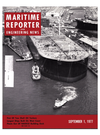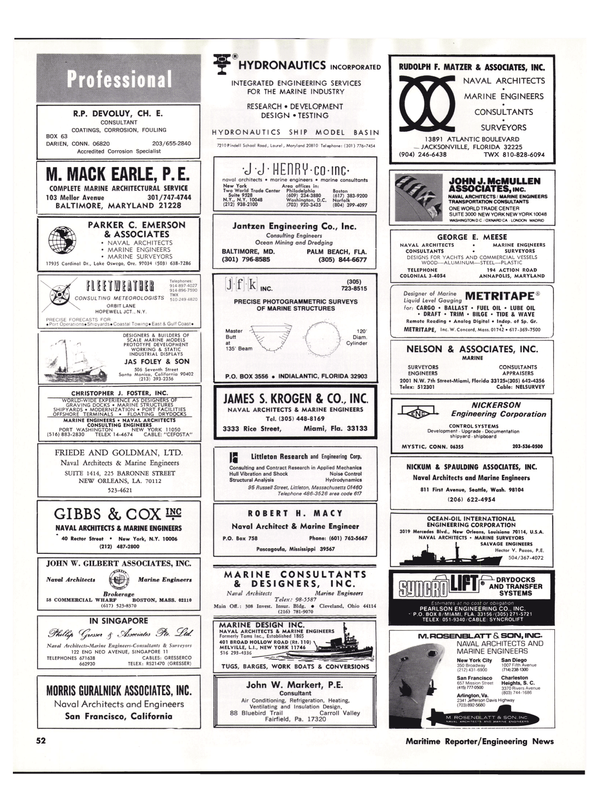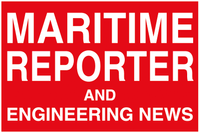
Lloyd's Register Completely Revises Rules For Marine Refrigerated Cargo Installations
Lloyd's Register has completely revised the Rules for Marine Refrigerated Cargo Installations to take account of advances in refrigeration engineering technology and changing patterns in the method of transporting refrigerated cargoes at sea.
Additions to the Rules as they relate to new construction are detailed below, and notes are given on certain revisions (See Section A) and omissions (See Section B).
Further notes (See Section C) are given on the revised sections dealing with the periodical survey of classed refrigerated cargo installations onboard ships in service.
ADDITIONS A new section sets out requirements for the design, construction and testing of refrigerating plant supplying cold air to insulated containers in ships' holds.
While many of the rules in other sections are applicable to refrigerated cargo installations onboard containerships, new rules have been formulated especially for ships carrying refrigerated containers.
A new rule, applicable to all classed refrigerated cargo installations, stipulates that the classed installation must be completely independent of any refrigerating machinery associated with air conditioning plant, domestic refrigerating installation or process plant, unless full details of alternative proposals have been submitted and approved.
The "Stand-By" or reserve unit may now be considered as an operating unit during the limited cooling-down period of a nonprecooled fruit cargo.
Rules relating to automated installations and to unmanned refrigerating machinery rooms are now included.
Rules have been added in Section 3 for the design and testing of rotary displacement compressors, now widely used for large capacity installations.
A new rule requires pressure vessels for use with ammonia above a stated size to be constructed to Class 2 / 1 or 2/2, with selected "Spot" radiography checks.
The rules now require pressure vessels designed for temperatures below minus 40 °C and for vessels with a design temperature below 0°C, where the pressure/saturation temperature relationship does not apply, to be manufactured from materials that have been specifically approved for the proposed operating conditions.
SECTION A REVISIONS Conditions to be complied with in order that the symbol J can be assigned to a classed installation have been amended to remove any ambiguity.
While in the past, it was recommended that a reasonable margin in plant output, over maximum load, be provided, it is now a requirement to design the plant to have at least 5 percent excess capacity over that required for the maximum design output for the desired class notation.
The formulae for determining the scantlings of compressor crankshafts have been completely revised, together with the table of pressures and the manner in which refrigerating plant components and completed installations are to be tested.
Alternative methods for preventing corrosion of the external surface of steel pipes conveying brine, other than by galvanizing, may now be approved and rules referring to the treatment of the surface of tank top plating in way of insulation have been revised.
The Section relating to insulating materials and methods of application and the rule requiring cargo battens to be fitted in insulated cargo spaces have been reappraised.
Cargo battens may now be omitted from insulated cargo chambers when fruit cargoes are carried, and alternative methods of maintaining air circulation between the insulated lining and frozen cargo, other than by cargo battens, may be accepted.
The rules associated with thermometers and electric remote reading temperature measurement equipment have been updated to take into account modern technology, digital electronic temperature recorders and similar appliances.
The rules setting out the procedure to be observed when carrying out the Society's thermal balance test have been enlarged and various points clarified.
All the plant is to be tested under working conditions and, when found to be operating satisfactorily, the capability of the installation to perform the specific duty necessary to maintain the carrying temperatures assigned with the maximum sea temperature specified, is to be determined by the Society's thermal balance test.
This test measures the capability of the combined plant and insulated chambers. It does not separately measure the insulation "U" value or the efficiency of the machinery.
A thermal balance test may also be required when an installation is being considered for reclassification, when extensive repairs or alterations have been carried out, or when an amended temperature notation may be required.
SECTION B OMISSIONS Reference to refrigerated cargo installations using C02 (Carbon Dioxide) as a primary refrigerant has been omitted, while rules related to the use of Refrigerant R502 are included for the first time.
Rules referring to steam engines, or oil engines, no longer used as prime movers to drive refrigerant compressors, and to evaporators and refrigerant condensers, of the "Coil - in - Casing type" (also no longer employed in modern refrigerating installations), have been omitted from the rules under review.
Reference to insulation, in way of coal bunkers and piping carrying a refrigerating medium through bunkers, has also been omitted.
SECTION C Survey of Classed Refrigerated Cargo Installations onboard ships in service The Sections dealing with periodical survey regulations have been completely rewritten and now present a new approach to the problem of inspecting and testing refrigerating installations without opening out machinery at what may be considered to be too frequent intervals. The period between opening out refrigerating plant and the manner in which surveys are held have been revised to be compatible with modern refrigerating engineering design and operational performance.
In future, an Annual Survey of the refrigerated cargo installation under service conditions is to be held at approximately 12-month intervals. (Within a period two months prior to, and two months subsequent to, the date of survey).
It should normally be possible to complete the Annual Survey without opening out the machinery, or dismantling the insulation arrangements, unless any defects are observed, when the surveyor may recommend the opening out of suspected items for further investigation.
At intervals of four years, a Special Survey is to be held as detailed in the revised rules. The Committee will give consideration to the Special Survey requirements being carried out on a Continuous Survey basis, which will normally require that one quarter of the refrigerating machinery and arrangements, insulated holds and chambers is surveyed annually.
The intervals between opening out screwtype compressors will be given special consideration on application, and individual consideration may be given to alternative survey arrangements for all components, when there is a program of replacement instead of surveys onboard ship.
At Loading Port Surveys, which are held when requested by the owner or his representative, or when carrying out an Annual Survey under service conditions, the surveyor is now required to pay particular attention to the power supply available.
At Annual Surveys, the surveyor is also required to examine the Refrigerated Cargo Installation Log Book.
The performance of the installation during the previous 12 months as recorded in the Log Book, especially during any period when the plant was required to operate at, or close to, maximum capacity, is to be appraised by the surveyor and any pertinent observations reported to the Committee.
Finally, the format used for these revised rules is similar to that which will be used for the 1978 Rules for Steel Ships.
Read Lloyd's Register Completely Revises Rules For Marine Refrigerated Cargo Installations in Pdf, Flash or Html5 edition of September 1977 Maritime Reporter
Other stories from September 1977 issue
Content
- Lloyd's To Class Two Large Crane Barges To Be Built By Mitsui page: 4
- Estimated Foreign Cost Of Two LNG Carriers $115.5 Million Each page: 6
- McAllister Brothers Name Robert Lounsbery Chief Operating Officer page: 7
- Lockheed Wins Contract To Evaluate Ocean Platform Candidates page: 7
- Bethlehem Steel Names G.Y. Marriner Manager San Francisco Yard page: 7
- AMPAC To Build Four Container Feeder Ships At Cost Of $92 Million page: 7
- MarAd Approves Title XI For Five Moran Tugboats page: 8
- SNAME New York Section Announces Program For 1977/1978 Season page: 8
- Willamette Awarded $15 Million To Modernize Alaska State Ferry page: 9
- Marathon Manufacturing Adds $61 Million To Drilling Rig Backlog page: 9
- NASSCO Building 188,500-DWT Tankers For Alaskan Oil Trade page: 10
- Exxon Begins Operating Remote Sea-Floor Production System page: 10
- Propeller Club Convention Includes Shipyard Panel page: 11
- MacMillctn Bloedel Orders Log Carrier At Cost Of $14 Million page: 12
- C-E Names Matthews Manager Of Contracts, Marine Power Systems page: 12
- Role Of Ro/Ro Shipping In Dry Cargo Trade page: 12
- Port Of New Orleans Presents Key To City To Egyptian Official page: 13
- Representatives Meet For First Time In Bahrain page: 14
- Marystown Shipyard Reports On Progress Of $23-Million Norwegian Tugboat Contract page: 14
- Dravo Awarded Two Contracts Totaling $7 Million page: 14
- Morris Guralnick Associates, Inc. Name Hubert E. Russell page: 14
- Canada's Newest Great Lakes Bulk Carrier Launched page: 16
- Todd Seattle Division Lays Keel For Royal Australian Navy Frigate page: 18
- Title XI Approval For Two IOT Subsidiaries page: 18
- Jerry D. Icenhower Named President Glitsch Cryogenics page: 18
- Hillman-Designed New Class Towboat Delivered To Exxon At Baton Rouge page: 19
- BP Invests $50 Million In Stolt-Nielsen page: 20
- Speakers Named For Weather Conference September 14-15-16 page: 22
- $45-Million Subsidy Repayment Approved page: 23
- Study Shows Worldwide LNG Production Increase —60 Carriers Needed page: 24
- Bethlehem Steel Subsidiaries Name Collins And Coulahan page: 25
- Gotaverken Converts Cargo Ship To Carry 32,000 Live Sheep page: 25
- Halter Marine Delivers Large Supply Boat To George Engine Co. page: 26
- Bethlehem Steel Shipbuilding Names Roland V. Danielson —Hollinshead De Luce Retires page: 26
- Perspectives On Third World Port Development page: 30
- APL Names Hubbard Senior VP Operations page: 31
- New National Supply Anchoring Windlass page: 31
- Shallow Water Maneuvering Trials Completed In Gulf page: 32
- Farrell Sale And Leaseback Agreement Approved By MarAd page: 32
- Delta Steamship Names Badger And Collins page: 32
- Gross Tonnage In ABS Classification Exceeds 100-Million Mark page: 33
- Airfilco Appoints Kevin McPherson page: 33
- CCN Of Brazil Launches New Type Bulk Carrier page: 33
- 51st Annual Propeller Club Convention And 1977 American Merchant Marine Conference Set For Galveston, Texas, Oct. 10, 11, 12, 13 And 14 page: 34
- Bulletin Describes Heavy-Duty Oil Filtration Systems page: 35
- Eight-Page Brochure Describes National's Fully Hydraulic Cranes page: 35
- Joseph Hurley Named President ITT Decca Marine page: 36
- Oceangoing Split Hull Self-Propelled Dredge Completes Trials In Gulf page: 37
- ITT Decca Marine Introduces 'Clearscan' New Radar Technique To Reduce Interference page: 38
- Todd Shipyards Los Angeles Division Lays Keel For First Of Six U.S. Navy Frigates page: 38
- MacGregor Slewing Ramps Successfully Tested page: 39
- Skagit Corporation Announces European Dealership Agreement page: 40
- FMC Marine & Rail Lays Keel For Ro/Ro Barge To Carry 374 Forty-Foot Truck Trailers page: 40
- Egyptian Shipyard Receives License To Build Willard Boats page: 42
- Bergeron Industries Names Captain Tatman page: 42
- Port Authorities (AAPA) 66th Annual Convention Set For Mexico City page: 43
- Lloyd's Register Completely Revises Rules For Marine Refrigerated Cargo Installations page: 44
- Tanker Design Change Approved By MSB page: 44
- Navy Contracts For Additional Years Of MARISAT Satellite Service page: 46
- Mitsubishi Receives Tug Barge Systems' License To Build page: 46
- Petro-Marine Names Murray Burns Manager Process Engineering page: 47
- Norshipco Dedicates New $5-Million Repair Pier page: 47
- COMSAT General Expands MARISAT Services To Entire Indian Ocean page: 48
- U.S. Lines Names Three In Operations page: 48
- Fetzner Named President Sun Trading & Marine page: 48
- Philippine Center Exhibit Highlights Filipino Seaman page: 49
- Henschel Announces New Steering-Failure Alarm page: 49
- Tulsa Port Of Catoosa Sets Tonnage Record page: 49
- Jane's Fighting Ships 1977-78 Revised Edition page: 49
- Stanford Research Awarded $271,000 For Firefighting Study page: 50
- Gulf Oil Trading & Transportation Announces Management Changes page: 51
- Renegotiation Board Erred In Computing Lockheed Steel Usage page: 51
- Pott Industries Names Miller VP Offshore Marine Services Div. page: 54
- Joseph R. Burgess To Head Central Pacific Shipping Agency page: 56
- Capt. James F. McNulty New Dean At Maine Maritime Academy page: 56
- Richard Daschbach Named Federal Maritime Commission Chairman page: 57
- Keene Brochure Describes Marine Discharge Control System page: 57
- Heavy Weather Ship Operation Subject Of Webb Seminar page: 58


